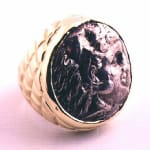Siculo-Punic Silver Tetradrachm, 300 BCE
Silver/Gold
FJ.5719
During the 4th century B.C., the Carthaginians issued silver tetradrachms in Sicily for the payment of mercenaries in the wars against the Greeks. Known as siculo-punic coins, these tetradrachms were...
During the 4th century B.C., the Carthaginians issued silver tetradrachms in Sicily for the payment of mercenaries in the wars against the Greeks. Known as siculo-punic coins, these tetradrachms were stunning in both craftsmanship and imagery, as evidenced in this distinctive silver coin. The front of the tetradrachm depicts the head and neck of a magnificent horse. With mouth open wide and stylized mane flying in the wind, we can almost feel his ancient kinetic spirit. An accompanying image of a small palm tree appears to the right of the horse. On the reverse side of the coin the powerful head of the Greek God Heracles appears, one of the most popular deities in classical antiquity. Through the centuries his name has been synonymous with strength and adventure. Heracles was said to be the son of Zeus, king of the Olympian gods, and Alcmene, a mortal queen. His earliest feat of strength, performed while still in the cradle, was to strangle two serpents sent to kill him by Hera, jealous wife of Zeus. The tales about Heracles' adventures are the most numerous in ancient classical mythology. His most famous exploits are the "twelve labors,” difficult tasks performed with a mixture of skill, and cunning and sheer strength. Here, Heracles is depicted in a lion skinhead dress, representative of the first of his labors. How apropos that the Ancient Carthaginians should portray this fierce warrior on coins minted during their war with the Greeks. Today, the imagery on this magnificent coin, framed in a regal gold ring setting, is every bit as powerful as it was centuries ago. The spirited energy that emanates from the wild horse and the undefeated Heracles continue to express it most effectively.



